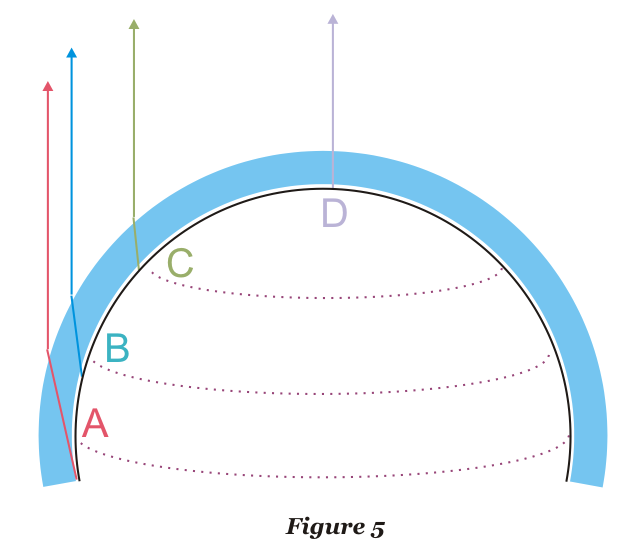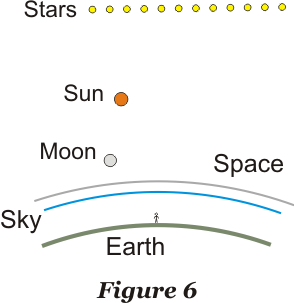The Sky Proves That the Earth is Round
In spirited discussions my mathematician friend has generously undertaken to educate me in the standard model.
I too have a science background, and am aware of the mathematical rapture and machinations of accepted cosmology. Yet it is quite clear to me that the Earth is flat.
At wit's end frustration my friend avers that the Earth is proven round by looking up at the sky. He says that there is no point looking down, and any evidence suggesting the Earth is flat is immaterial.
He is a thoughtful and intelligent man, and he presents a compelling argument. Let's look at it to find if it is, as he claims, an incontrovertible proof that the Earth is round. His argument goes like this:
Aiming your sextant at Polaris, the ground angle exactly matches your latitude. If you stand at D, the North Pole, Polaris is directly overhead. At C, the Arctic Circle, the sextant will show 30 degrees. And at A, the equator, Polaris will be seen exactly at the horizon.
Now according to the standard model, Polaris is so far away that view lines at A, B, C, and D will be effectively parallel (as shown on the right side of Figure 4).
Navigators use this sextant measure to determine their latitude. There is wide agreement about the correctness of these measurements, although the US Navy publishes a table of small angular corrections from measured to "actual".
One difficulty with the argument is that Polaris is seen from latitudes South of the equator.
The standard model accounts for this with the observation that a miles thick layer of atmosphere is wrapped around the Earth. The outer limit of the atmosphere is adjacent to empty space.
|

|
|
Empty space is less dense than air, and light travels faster in space than in air. This causes refraction, so according to Snell's law the light rays converge as seen in figure 5.
The view from D is straight up as before because the demarcation is at a right angle to the incident ray. The accepted value for the standard model is 0.6 degrees at A, so Polaris is seen as far South as 0.6 degrees South latitude.
Yes indeed, the argument seems compelling, but then I pointed out that credible mariner's logs show that they saw Polaris from as far South as the Tropic of Capricorn.
|

|
|
No they didn't!
This sort of thing makes it difficult to carry on a conversation. Observations inconsistent with the standard model are flatly denied. As Rowbotham didn't see his boat and thousands of Michigan beachgoers didn't see Chicago, mariners who claimed to have seen Polaris from South of the equator were insane, drunk or just wrong. But gainsaying the evidence presents no argument and adds nothing to the discussion.
I tried another approach. Polaris, according to the standard model is between 323 and 434 light years distant. Apparently light from this distant star has traveled through space for 400 years with no losses. It was not interrupted by clouds of dark matter or cosmic dust. In fact the trillions of miles of space between are so empty that Polaris has never been occluded for even a minute. Moreover, as light energy is reduced in proportion to the square of the distance traveled the source must be so enormously energetic as to make our sun seem a mere thin candle by comparison. But no, the sheer unlikeliness of this proposition didn't faze my scientist friend because the standard model is perfect and could not be wrong in any detail.
When I look up at Polaris, I see a light in the sky. Nothing about that spot of light tells me that it comes from a giant fusion reactor trillions of miles away. In fact it looks just like the spot of light we see projected inside the dome of a planetarium. Do we really have a way to know what it actually is? Until somebody goes there and returns with vacation videos, all we have is speculation. To claim it is more is the definition of scientific hubris.
Yes, I understand that spectral analysis finds characteristic patterns resembling the Balmer Series or the Lyman Series suggesing a Doppler redshift and from this we "know"
stars are individual objects moving away from us. Given however, that this model is contraindicated by common observations, is it not more reasonable to seek an alternative explanation?
To expose all of the anomalies and all of the circular reasoning in scientific orthodoxy would take a long paper indeed, so perhaps we should turn our attention instead to finding a model that fits all of the verifiable evidence.
|
The cosmology we were taught in kindergarten is shown at right in schematic form. Our observer, standing on the round Earth, looks up through the sky. The moon is the nearest object, the sun is a bit farther, and the stars are very distant.
Our observer has never been to the stars, the sun, or even the moon, but he can see them from his location on the surface of the Earth.
I present for discussion a little thought experiment. Given that we can prove the Earth is flat, perhaps the sky is also flat and we should unroll the curve as shown in figure 7.
|

|
|
Perhaps this is the right time to expose another difficulty with the standard model. Orthodoxy makes a number of interlocking assumptions. One of these is the notion that space is empty.
If space is indeed empty, the model shown at right is voided by the observation of Polaris with respect to ground angles.
|

|
|
But suppose the distant sky is made of a dense medium like heavy glass. Again using Snell's law to understand refraction, we see that the perception angle to celestial objects like Polaris falls away sinsoidally, in a manner possibly consistent with mariners' observations.
|
An observer at the "North Pole" sees Polaris directly overhead as we expect. The farther "South" an observer is, the lower Polaris is seen in the sky. At equatorial latitudes Polaris is very close to the horizon. If atmospheric conditions are extremely favorable, Polaris will be seen at latitudes well South of the equator.
|

|
|
When an observer is far enough to the South, a critical angle is reached (green view line), the view is reflected and Polaris disappears. Depending on height, thickness and density of the glass sky, such a model could give the same sextant readings from pole to equator. Results would differ from the standard model at the outer limits as the cutoff would be indistinct and dependent on atmospheric conditions.
Observed phenomena are better described by this glass-ceiling model than by the standard model. I haven't seen this elsewhere so it is perhaps stated here for the first time. I am certain though, the Bible scholars will say "That's the firmament. We knew it all along.".
Given that the Earth is seen to be flat, and is proven to be flat, celestial observations strongly imply that space is not empty.
|
|








